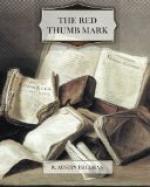“Now let us consider this question by the light of the evidence. This thumb-print was either made by the prisoner or it was not. What evidence has been brought forward to show that it was made by the prisoner? Well, there is the evidence of the ridge-pattern. That pattern is identical with the pattern of the prisoner’s thumb-print, and even has the impression of a scar which crosses the pattern in a particular manner in the prisoner’s thumb-print. There is no need to enter into the elaborate calculations as to the chances of agreement; the practical fact, which is not disputed, is that if this red thumb-print is a genuine thumb-print at all, it was made by the prisoner’s thumb. But it is contended that it is not a genuine thumb-print; that it is a mechanical imitation—in fact a forgery.
“The more general question thus becomes narrowed down to the more particular question: ‘Is this a genuine thumb-print or is it a forgery?’ Let us consider the evidence. First, what evidence is there that it is a genuine thumb-print? There is none. The identity of the pattern is no evidence on this point, because a forgery would also exhibit identity of pattern. The genuineness of the thumb-print was assumed by the prosecution, and no evidence has been offered.
“But now what evidence is there that the red thumb-print is a forgery?
“First, there is the question of size. Two different-sized prints could hardly be made by the same thumb. Then there is the evidence of the use of appliances. Safe-robbers do not ordinarily provide themselves with inking-slabs and rollers with which to make distinct impressions of their own fingers. Then there is the accidental mark on the print which also exists on the only genuine print that could have been used for the purpose of forgery, which is easily explained on the theory of a forgery, but which is otherwise totally incomprehensible. Finally, there is the strange disappearance of the ‘Thumbograph’ and its strange reappearance. All this is striking and weighty evidence, to which must be added that adduced by Dr. Thorndyke as showing how perfectly it is possible to imitate a finger-print.
“These are the main facts of the case, and it is for you to consider them. If, on careful consideration, you decide that the red thumb-print was actually made by the prisoner’s thumb, then it will be your duty to pronounce the prisoner guilty; but if, on weighing the evidence, you decide that the thumb-print is a forgery, then it will be your duty to pronounce the prisoner not guilty. It is now past the usual luncheon hour, and, if you desire it, you can retire to consider your verdict while the Court adjourns.”
The jurymen whispered together for a few moments and then the foreman stood up.
“We have agreed on our verdict, my lord,” he said.
The prisoner, who had just been led to the back of the dock, was now brought back to the bar. The grey-wigged clerk of the court stood up and addressed the jury.




